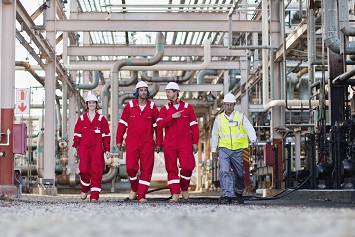Safety committee members are there for their organizations, employees, and each other. So, do you need a safety committee? Depending on your company size and location, the hazards present in your facility, or past workers’ compensation claims, you may be required to have one. Safety committees also may be required if you have a collective bargaining agreement with some or all of your employees.
Some labor unions consider health and safety contract provisions almost as important as wage and hour provisions. Others see safety committees as a way to exercise leverage over the organization of work and standard operating procedures. Some contracts even authorize union or joint labor-management safety committees to shut down operations until health and safety hazards are corrected.
Some national labor unions and the National Council for Occupational Safety and Health suggest state and local members exercise the leverage afforded by health and safety clauses. For example, the Massachusetts Coalition for Occupational Safety and Health encourages close coordination among bargaining and safety committee members and shop stewards.
Safety committees also can be extremely effective. Having one could reduce the number of workplace injuries and illnesses and workers’ compensation claims while bolstering your compliance with federal or state occupational safety and health regulations.
State requirements for safety committees and safety management programs have had the greatest potential for injury reduction, according to a study of the impact of state workplace safety laws.
Most states do not require employers to establish safety committees. However, 14 states require an employee/employer safety committee at some or all workplaces in their jurisdictions.
Six states—Connecticut, Minnesota, North Carolina, Tennessee, Vermont, and West Virginia—require safety committees at high-hazard or high-risk workplaces. Definitions of “high-hazard” and “high-risk” usually are based on a high experience modification rate (EMR); high days away, restricted, or transferred (DART) rate; or high workers’ compensation insurance premiums.
Alabama requires employers to form a safety committee if employees request one. Eight states use establishment size as a criterion for requiring a safety committee, ranging from 5 or more employees in Montana to 25 or more employees in Connecticut, Nevada, and Minnesota.
Employers in California may use safety committees to satisfy the communication requirement of the Injury and Illness Prevention Program (IIPP) standard. Oregon employers must either form a safety committee or hold safety meetings to communicate and evaluate workplace safety and health issues. Colorado employers may be entitled to a workers’ compensation insurance premium discount by creating a safety committee, along with meeting other requirements.

Joint and Union Committees
Some collective bargaining agreements may insist on creating joint labor-management safety committees. Other bargaining units may have a health and safety committee composed entirely of union members. A union safety committee may complement a joint labor-management committee, and the joint committee may include members of the union committee. However, union safety committee members may coordinate with union shop stewards to represent employees with health and safety grievances.
A safety committee’s basic purpose is to “find and fix” workplace hazards. Finding and fixing hazards are ongoing responsibilities, as duties, equipment, and work practices change. Safety audits or health and safety inspections are not “one and done” activities.
Having a safety committee can help achieve the management involvement and employee engagement needed in a workplace safety and health management program. Conversely, levels of management support and employee enthusiasm can make or break a safety committee.
A safety committee also can foster employee engagement by internally publicizing its accomplishments.
An effective committee needs to determine its function and responsibilities within the overall organization, decide on the frequency of its meetings, and establish a budget. A committee’s membership should include both hourly and salaried employees across departments or organizational functions. The makeup of a committee may determine its effectiveness.
The committee should be large enough so that all departments are represented. In a workplace where there are multiple collective bargaining agreements, committee membership may need to include workers from all bargaining units. Some collective bargaining agreements may specify the makeup of a joint labor-management safety committee, even covering the ratio of management to labor union members.
Regularly refreshing or rotating members can help protect against “groupthink,” when committee members may fail to recognize certain hazards or potential controls.
Inadequate size, insufficient budget, lack of training, and poorly defined member roles can hamper the effectiveness of a safety committee. Other potential impediments include begrudging or lackluster participation; domination by management; inability to implement changes; and a lack of communication, follow-up, or formal meeting agendas.
Purpose, Function of Safety Committees
A committee’s purpose could begin with basic safety committee functions, including:
- Developing an annual safety plan of action with specific goals, which could be modest at first; a committee should seek progress before perfection, as no workplace is perfectly safe.
- Conducting periodic health and safety inspections to identify hazards and confirm adherence to safety rules and company safety policies and practices.
- Investigating accidents, illnesses, injuries, and near misses, as well as health and safety complaints, to develop recommendations for corrective actions, equipment purchases such as machine guards or personal protective equipment (PPE), or new policies or safety rules.
- Coordinating or conducting safety training.
- Developing health and safety policies and procedures, which could include maintaining a safety manual covering all active workplace hazards, and creating job-specific checklists.
- Aiding, as well as consulting, various departments on safety and health issues.
Committee members should develop a walk-through checklist or worksheet before conducting health and safety inspections.
Health and safety inspections may have a heavy emphasis on ergonomics hazards, especially in workplaces with collective bargaining agreements. A Bureau of Labor Statistics (BLS) study found that the most common occupational health clause in collective bargaining agreements is a clause authorizing the safety committee to evaluate and control ergonomic health hazards.
Safety committees also may focus on chemicals used in the facility and review safety data sheets (SDSs) to better understand exposure hazards. Committee members may seek input into chemical and equipment purchasing decisions. Elimination and substitution are top measures in the hierarchy of hazard controls.
Other issues that a safety committee could review may include:
- Administration of and compliance with any drug-free workplace policies, including provision of employee assistance programs (EAPs) or reimbursement for addiction and recovery treatment;
- Areas where medical surveillance is required or recommended;
- Emergency procedures for responding to explosions, fires, and spills;
- Hazard communication or worker right-to-know programs;
- Preoccupancy inspection of leased spaces;
- Protective clothing and equipment use, including respirators, and effectiveness of employee PPE training;
- Records of exposure or air monitoring to assess workplace air contamination or exposures to hazardous substances;
- Reviewing injury and illness logs and workers’ compensation records for analysis of health and safety hazards;
- Standard operating procedures, possibly including an annual review of the effectiveness of rules and procedures; and
- Workplace housekeeping throughout the facility.
Fact-Finding Beyond Walk-Arounds
Safety committees may use other fact-finding methods beyond a periodic walk-around or health and safety inspection. Safety committees also may perform surveys of workers to identify health and safety concerns or conduct studies of specific workflows or processes to identify hazards in need of controls. Health and safety studies can include specific job hazard analyses.
Depending on the safety committee members’ sophistication, hazard identification or risk assessment may go as far as analyses of leading indicators. Injury and illness logs and workers’ compensation claims are types of “lagging indicators.” Leading indicators are pre-incident measurements. Levels and types of training, hazard assessments, and observation are all leading indicators that can reduce injuries and illnesses.
The safety committee should have the authority to choose or recommend control devices, such as barriers and guardrails, PPE, and ventilation systems. Safety committees in some workplaces may actually have the authority to temporarily shut down unsafe operations until a hazard is corrected.
Committee members may need training in accident and incident investigation practices. Members may also need “train the trainer” training if the committee decides to conduct its own workplace health and safety training. Some members may need additional materials, depending on their experience. They may be unfamiliar with the environment, health, and safety (EHS) function.
Your organization’s safety director or EHS manager may or may not be a formal member of your safety committee but certainly is a resource for committee members. A safety director or EHS manager can recommend materials and training for safety committee members.
Safety committees may even benefit from the experience and “lessons learned” in other industries that could be applicable to their own. For example, equipment and practices effective in health care could be applicable to hazards in construction or oil and gas extraction. Members may benefit from attending cross-industry conferences or seminars.
Meetings, Minutes
Some states have requirements for committee meeting frequency. For instance, Oregon requires committees in workplaces where employees mostly do office work to meet quarterly and committees in workplaces where employees do nonoffice work to meet monthly.
The committee should choose a chairperson to run committee meetings and keep committee members informed. The committee chairperson should prepare and distribute meeting agendas to committee members so they can make appropriate preparations for upcoming meetings. The conduct and tone of safety committee meetings should remain businesslike. Safety committee meetings should not become a forum for airing grievances.
The committee also should keep meeting “minutes” or notes. Some states require safety committees to keep detailed records of meetings. Meeting records should include the names and titles of committee members attending and issues discussed, as well as any decisions made about recommendations or the committee’s next actions. Record retention requirements vary by state.
At meetings, members should discuss employee health and safety concerns and any recent or ongoing accident investigations. Committee members can discuss any accident or incident causes and possible corrective actions, then agree on recommendations for any changes to equipment, policies, and practices.
The basic purpose of a safety committee is to identify both workplace health and safety hazards and controls that could effectively prevent accidents, illnesses, and injuries. The role and scope of a safety committee can vary widely depending on facility location and whether employees have a collective bargaining unit. A labor contract may have extensive health and safety provisions, and the authority of a union or joint labor-management safety committee can be wide-ranging.
However, having a safety committee can reduce workplace injuries and illnesses and may even help with the number and cost of workers’ compensation claims or workers’ compensation insurance premiums.


